Panzer IV Tank Ausf. G
This German Panzerkampfwagen IV tank Ausführung G can be found at the Deutsches Panzermuseum in the small military town of Munster, Germany.
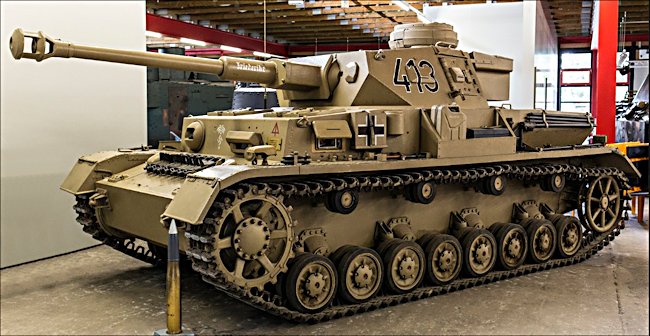
German Panzer IV Tank Ausf G with the upgraded long barrelled 75mm gun
This tank's history
This tropical versions of the Panzer IV was built by Voigtländer Maschinenfabrik AG based in Plauen, Germany. It was shipped to North Africa via Italy. It was captured by British troops after it was abandoned by its tank crew after it developed a mechanical breakdown (or possibly lack of fuel). It only had 482 km recorded on its odometer. On 1st December 1960 this tank was given as a gift to the German Tank Museum by Major General Jolly, Commander of the 5th British Tank Division.
The Panzer IV
In 1940 the best and most heavily armoured tank of the German army, the Panzer IV tank, only accounted for 10% of the tanks available to the commanders of the Panzer Divisions during the battle of France. It was an oversight, which could have potentially been disastrous stop.
Throughout its long career, the Panzer IV tank was to prove a remarkably versatile design. There are those historians that say, if the Germans had stuck with the Panzer IV tank and built large numbers of them, they would have done a lot better rather than messing around with the complicated and difficult to produce Tiger and Panther tanks.
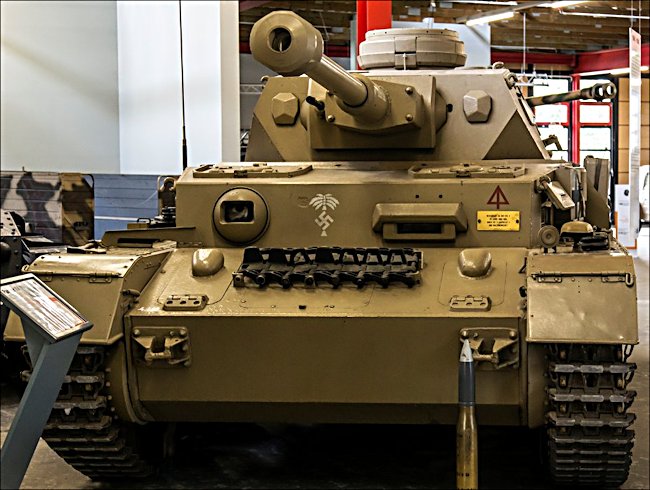
Notice the driver's side vision hatch is open on this Panzer IV Tank Ausf G
The reason is that this tank was superb all-round design. It was in service when war broke out in 1939 and it was still an effective front line tank at the end of World War II. The reason is that the German tank designers built expandability into this combat vehicle. The armour thickness increased three times over the period of the war. The extra weight does not affect the overall performance of the tank.
The Panzer IV tank's main gun, although it does not increase calibre, increases in size from the short barrelled 75mm to the long barrel high velocity 75mm gun. This enabled it to keep pace with developments in enemy tank technology. It could knock out all tanks fielded by the allies during the Second World War.
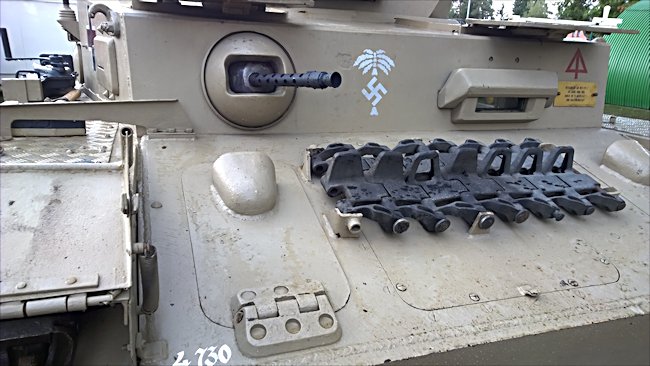
German Panzer IV Tank Ausf G
Over the years maintenance issues were ironed out. The Panzer IV became a reliable frontline battle tank, unlike the newly arrived Panther and Tiger tanks, which were prone to mechanical breakdown.
On the eve of the blitzkrieg attack through the Belgium Ardennes in may 1940 the German tank is consisted of 500 Panzer I light tanks, 1000 Panzer II light tanks, 350 Panzer III medium tanks, 400 Czechoslovakian made Panzer 38(t) tanks and though the 200 operational Panzer IV tanks.
One of the reasons the outnumbered German attack force succeeded in the battle of France was the poor tank tactics used by their opponents. The French had better tanks. They were heavily armoured and had bigger guns. Rather than fighting together in an armoured division they were spread out in small numbers. The German tanks could overwhelm them and find weak spots in their armour.
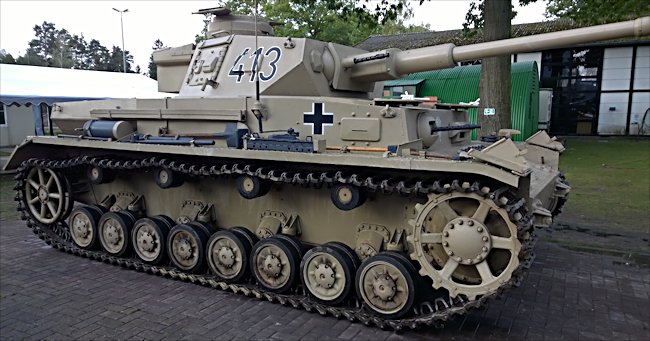
You can always tell the German Panzer IV Tank chassis as it has eight track wheels unlike the Panzer III which is shorter and only has six.
The way the superb German tank division commanders deployed their resources as a coordinated fighting unit so successfully in France hid many of the deficiencies of many German tanks used in 1940. They received a very nasty shock during the invasion of Russia using the same armoured vehicles they had used to attack France. They were totally outclassed by the new Russian T 34 and KV-1 tanks. In response the Panzer IV was up gunned and its armour was increased.
This also benefited the German Afrika Corps as the tanks arrived in Libya were these upgraded models. They were very effective against thinly armoured British cruiser tanks. It always tell the difference between a Panzer III and Panzer IV tank by looking at the track wheels. The slightly smaller Panzer III tank has six road wheels, whereas the longer Panzer IV has eight.
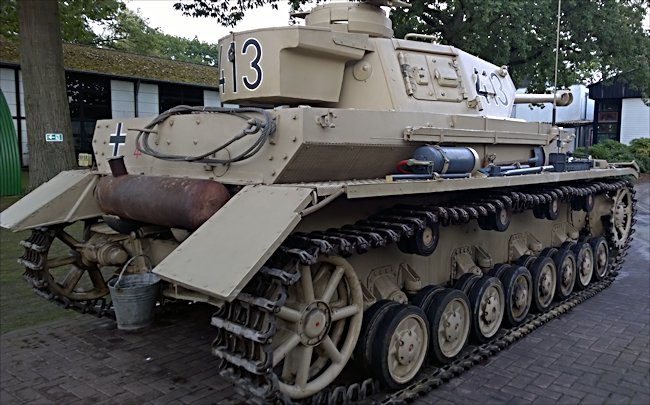
German Panzer IV Tank Ausf G always had large escape hatches which gave the crew confidence that they had a reasonable chance of getting out of the tank quickly. This was not true in many Allied tanks.
Bazookas - Post D-Day Bocage Country fighting
According to Panzer Lehr commanding officer Bayerlein's own figures, his panzer regiment had been reduced from 2,200 men and 183 tanks down to just 400 men and sixty-five tanks by the time he reached the American sector in 7 July. The 901st Panzergrenadier-Regiment was reduced from 2,600 men to 600, and the 902nd Panzergrenadier-Regiment from 2,600 to 700.
Bayerlein's men were also exhausted, having never been pulled out of the 'line for a rest. When he had protested to Seventh Army head-quarters, he was told not to worry because the Americans were poor soldiers.
Bayerlein then warned Choltitz that the Panzer Lehr 'was not in a position to make a counterattack'. Choltitz apparently retorted that he was a liar, 'like all panzer commanders', and that he must attack anyway.
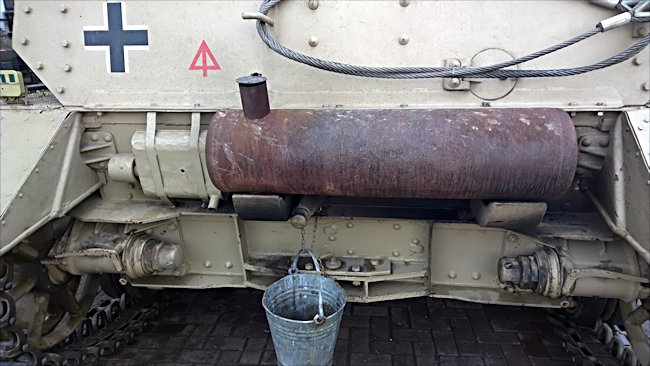
German Panzer IV Tank Ausf G
Bayerlein was not exaggerating about the state of his division when it left the British sector. Geyr von Schweppenburg had written, Because of its exhausted condition, the division was regarded by I.SS Panzer Corps as being in a critical situation'.
Bayerlein had no option but to divide his remaining tanks, panzergrenadiers and artillery into three battlegroups. The strongest would attack from Pont-Hebert, the second up the road from Coutances towards Le Dézert, and the third from the Bois du Hommet towards Le Mesnil-Veneron.
During the night of 10 July, American infantry in forward positions reported the noise of tanks, and in the early hours of 11 July, Panzer Lehr units began to attack in the wooded hills south of Le Dézert and against a battalion of the 120th Infantry on Hill 90 near Le Rocher.
Although individual Mark IV tanks broke into the American positions, bazooka teams dealt with them quite promptly in isolated actions. The German attack from Pont-Hébert along the west bank of the Vire was also beaten off with bazookas and the assistance of tank destroyers.
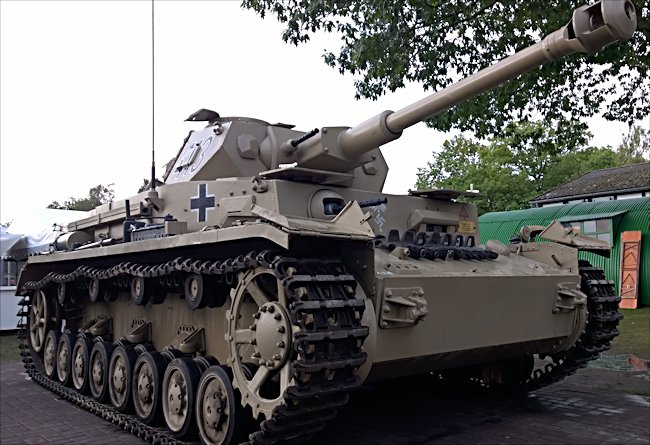
German Panzer IV Tank Ausf G
A few miles to the west, other groups of tank destroyers managed to ambush Panthers tank as they approached. Several 76mm rounds were often needed to knock out a Panther completely. They destroyed twelve Panthers and one Mark IV tank.
The Panzer Lehr offensive came to a complete halt after the central Kampfgruppe was sighted south of Le Dezert and then bombarded by 9th Division artillery and attacked by P-47 Thunderbolts and P-38 Lightnings. The Panzer Lehr had been badly mauled, losing twenty tanks and assault guns as well as nearly 700 men.
Bayerlein blamed his men's exhaustion and the unsuitability of the Panther and the long barrelled Panzer Mark IV tank among the hedgerows, which reduced their principal advantage of firing at long range.
Where can I find other preserved Panzer IV Tanks?
- Pz Kpfw IV Ausf. D - Australian Armour and Artillery Museum, Cairns, QLD, Australia
- Pz Kpfw IV Ausf. D - Imperial War Museum Duxford England
- Pz Kpfw IV Ausf. D - Bovington Tank Museum England
- Pz Kpfw IV Ausf. D - Fort Lee, US Army Ordanance Museum VA, USA
- Pz Kpfw IV Ausf. F - Central Museum of the Great Patriotic War 1941 - 1945, Park Pobedy, Moscow, Russia
- Pz Kpfw IV Ausf. G - 2x Museum of Battle Glory, Yambol, Bulgaria
- Pz Kpfw IV Ausf. G - National Armor and Cavalry Museum, Fort Benning, GA, USA
- Pz Kpfw IV Ausf. G - Wheatcroft Collection England
- Pz Kpfw IV Ausf. G - Deutsches Panzermuseum Munster Germany
- Pz Kpfw IV Ausf. G - Herr Hoebig Collection, Germany
- Pz Kpfw IV Ausf. G - Etimesgut Tank Muzesi, Ankara, Turkey
- Pz Kpfw IV Ausf. G - Tank Museum in Kubinka Russia
- Pz Kpfw IV Ausf. G - Wehrtechnische Dienststelle Meppen, Germany
- Pz Kpfw IV Ausf. G - Muzeul Militar Naţional Romania
- Pz Kpfw IV Ausf. G - Military Vehicle Technology Foundation Norway
- Pz Kpfw IV Ausf. H - Militärhistorisches Museum, Dresden, Germany
- Pz Kpfw IV Ausf. H - Musée des Blindés, Saumur, France
- Pz Kpfw IV Ausf. H - Normandy Tank Museum, Catz, France
- Pz Kpfw IV Ausf. H - Omaha Overlord Museum, Colleville-sur-Mer, Normandy, France
- Pz Kpfw IV Ausf. H - Unidad de Servicio de Acuartelamiento 'Diego Porcelos', Burgos, Spain
- Pz Kpfw IV Ausf. H - El Empecinado military base, Cabezón de Pisuerga, Spain
- Pz Kpfw IV Ausf. H - El Goloso Museum Spain
- Pz Kpfw IV Ausf. H - Kalemegdan Military Museum Serbia
- Pz Kpfw IV Ausf. H - Museum of Battle Glory, Yambol, Bulgaria
- Pz Kpfw IV Ausf. H - Yad la-Shiryon, Latrun Israel
- Pz Kpfw IV Ausf. H - Royal Jordanian Tank Museum, Jordan
- Pz Kpfw IV Ausf. H - AAF Museum, Danville, VA, USA
- Pz Kpfw IV Ausf. J - Rex and Rod Cadman, Collection, England
- Pz Kpfw IV Ausf. J - Auto and Technik Museum Sinsheim, Germany
- Pz Kpfw IV Ausf. J - Bastogne Barracks, Bastogne, Belgium
- Pz Kpfw IV Ausf. J - Musée des Blindés, Saumur, France
- Pz Kpfw IV Ausf. J - Panzermuseum, Thun, Switzerland
- Pz Kpfw IV Ausf. J - Finnish Armour Museum, Parola, Finland
- Pz Kpfw IV Ausf. J - Savon Prikaati garrison, Mikkeli, Finland
- Pz Kpfw IV Ausf. J - Military Technical Museum Lešany, Czech Republic
- Pz Kpfw IV Ausf. J - Slovak Uprising National Museum, Banska Bystrica, Slovakia
- Pz Kpfw IV Ausf. J - Memorial SNP - National Historic Landmark, Svidnik, Slovakia
- Pz Kpfw IV Ausf. J - Muzeul Militar National, Bucharest, Romania
- Pz Kpfw IV Ausf. J - National Military History Museum, Sofia, Bulgaria
- Pz Kpfw IV Ausf. J - 2x Museum of Battle Glory, Yambol, Bulgaria
- Pz Kpfw IV Ausf. J - Batey ha-Osef Museum Israel
- Pz Kpfw IV Ausf. J - Migdal Ha Emek, Israel
- Pz Kpfw IV Ausf. J - Golan heights area, Israel
- Pz Kpfw IV Ausf. J - Wheatcroft Collection, England
- Source - Pierre-Oliver Buan - http://the.shadock.free.fr/Surviving_Panzers.html
WW2 tank books

